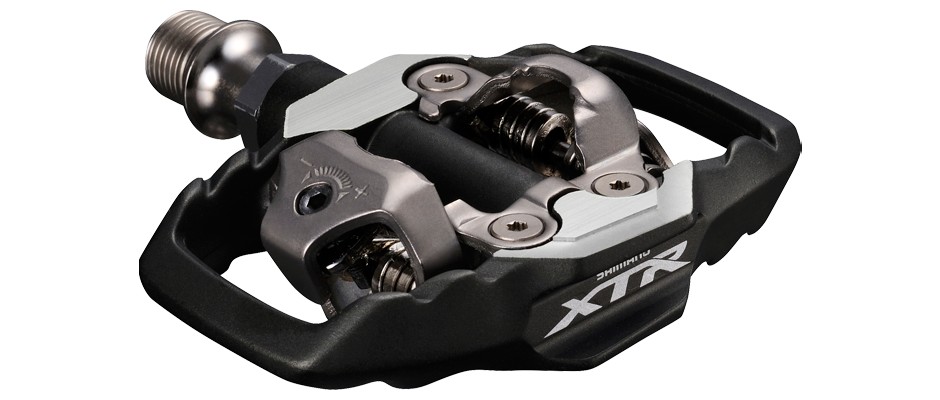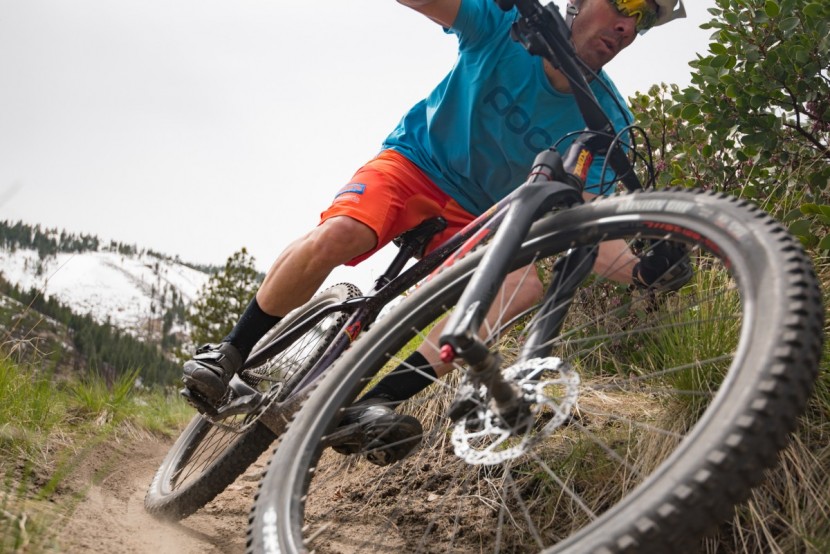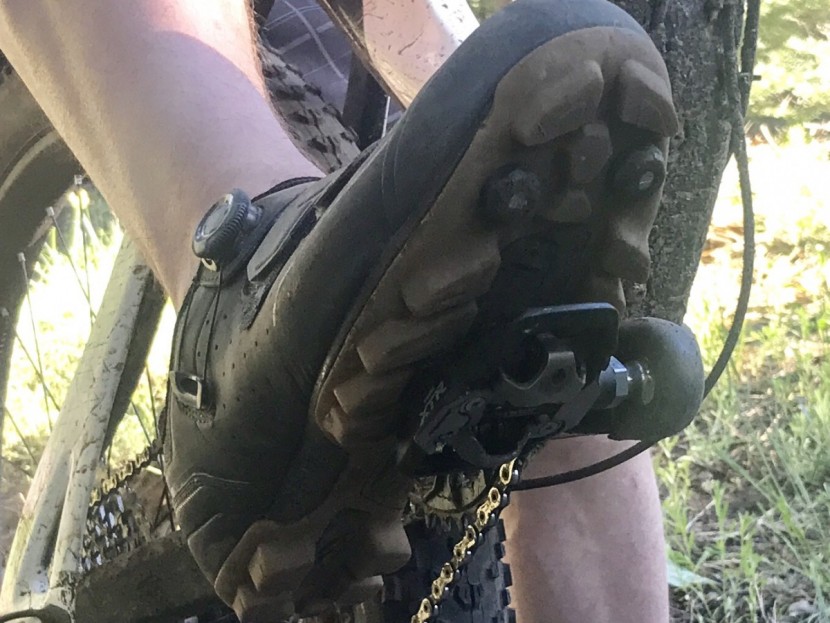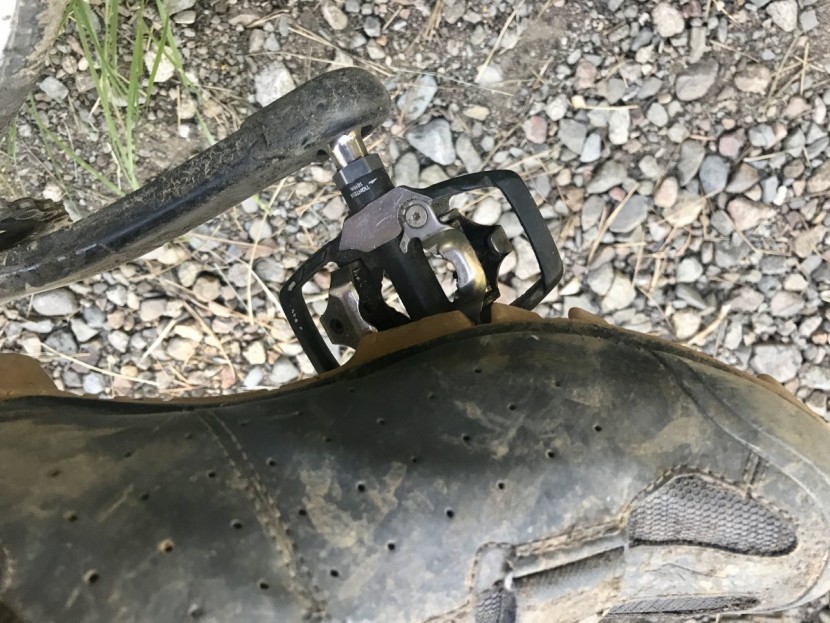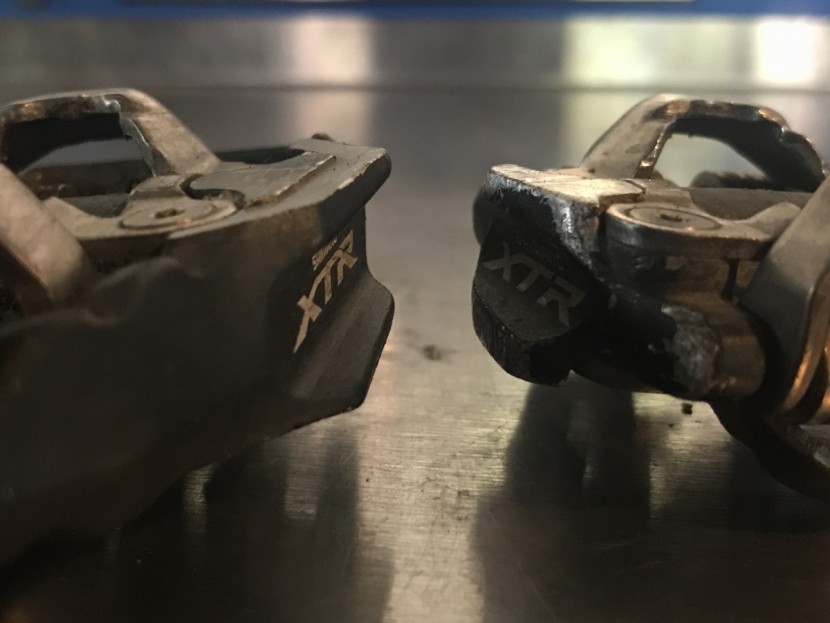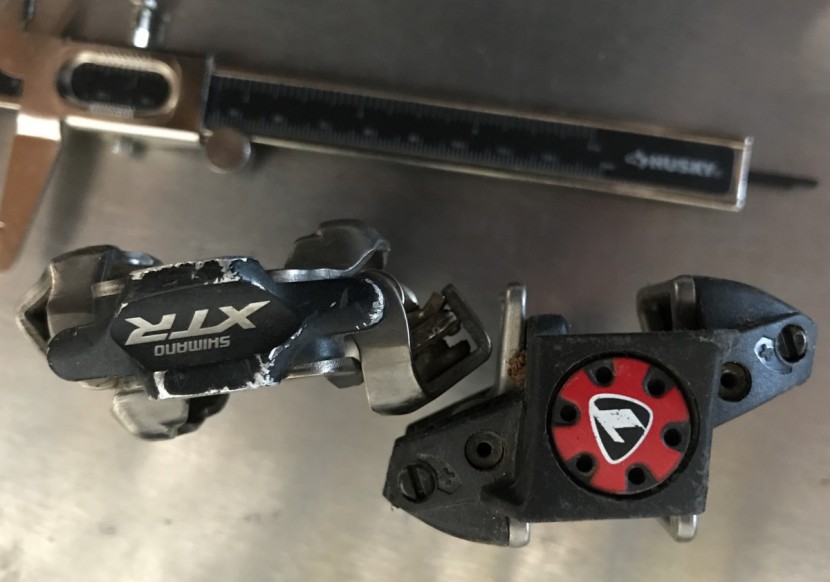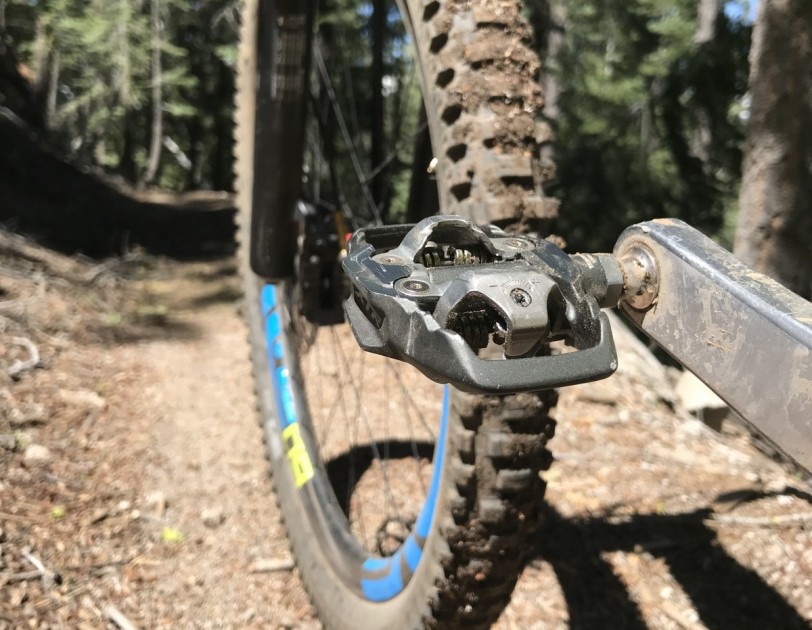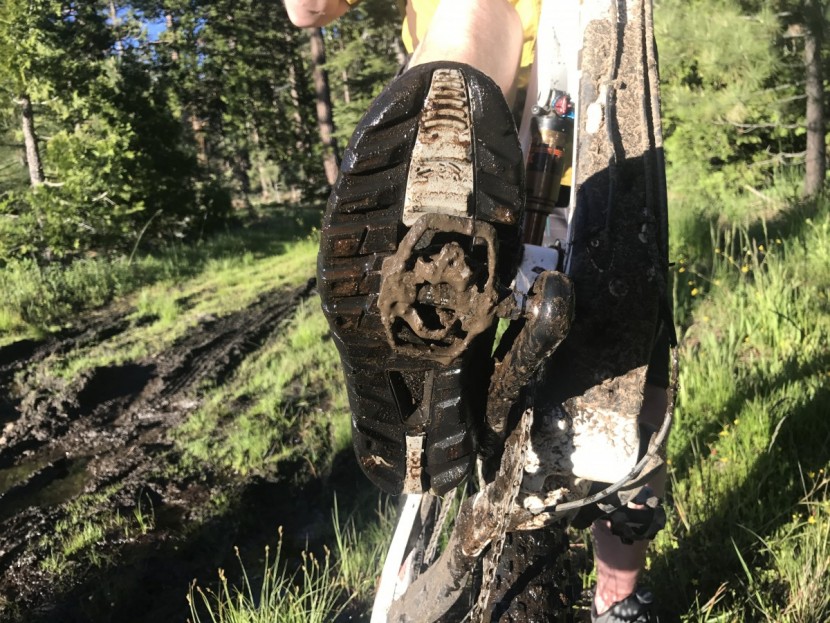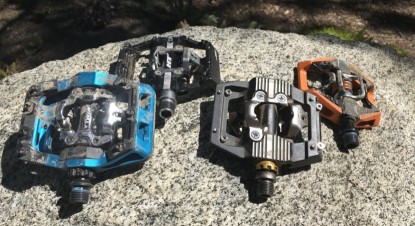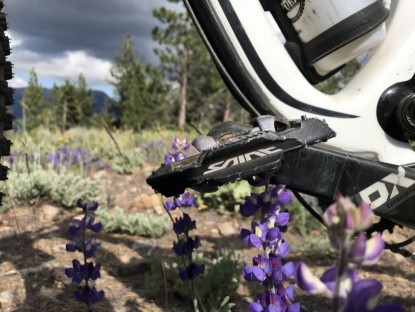Shimano XTR M9020 Trail Review
Our Verdict
Our Analysis and Test Results
The Shimano XTR M9020 Trail pedal is the lightest all-mountain version of their mini platform pedal currently in production. The anodized aluminum body has been meticulously sculpted to provide a minimal weight platform with maximum surface area for your shoe. The machined surfaces are smooth, and even the spindles are highly polished. The spindle housing has been ovalized to increase the size of the voids and aid in mud shedding. Common Phillips fixing screws found on lesser models were replaced with fancy hexalobular fasteners.
The pedals have a slippery, proprietary coating on the engagement mechanism to keep things smooth in the mud — we'll talk more about this later. Their hollowed out Chromoly axles are coupled with two sets of widely spaced angular contact bearings. Unlike almost every other Shimano mountain pedal, the XTR model uses 22 high polished steel bearings instead of the standard 24 per pedal. Fit and finish are what you'd expect from their top of the line offering. According to Shimano, all XTR pedals are hand assembled by highly skilled technicians in Japan, not the folks making the bulk of their goods in Malaysia.
Ease of Entry
The faster you can get into your pedals, the sooner you can start putting the power down and get moving. This testing metric is important, as the time spent unclipped can be disconcerting and feel precarious. The XTR Trail pedals are incredibly easy to engage, giving the cleats an almost magnetic feel. The mini platform lines the pedal up for near perfect engagement every time, flattening the pedal just before you engage. The slippery coating on the engagement mechanism allows your foot to drop right in with an incredibly slick feel, even when the muck and mud start to build up. Once engaged, moving through the four degrees of float is buttery smooth edge to edge.
The Shimano XT M8020, with a very similar feel, ranked second in ease of entry. The mini platform provides the same channeling toward the cleat feeling we experience on other Shimano mini platforms pedals but couldn't match the direct engagement of the XTR. They're not quite as slick feeling, especially when they start to accumulate mud and debris. The XTR pedal features an ovalized axle body and a bit less cage material, which do an excellent job at keeping entry simple.
Ease of Exit
Being able to quickly and efficiently get out of your pedals is arguably the most important attribute of clipless pedals. It's certainly the number one concern for first-time users and a significant performance quality for others. On Shimano's top of the line trail pedal, cleat disengagement is robust and reassuring, moving from the edge of the float is a fluid heel swivel.
There's no second guessing this SPD mechanism, regardless of the release tension you've chosen. By contrast, the Crankbrothers Candy 7, while easy to release, do not provide the reliable audible confirmation and snappy feel that you'll find on the SPD. As with other mini-platform pedals, the platform serves as a stabilizing base for your shoe while engaged. Once unclipped, however, the platform provides minimal perch, and the buttery smooth feel of the XTR can come back to bite you here, as most of our test shoes failed to maintain traction.
Adjustability
This metric addresses how much the pedal can be augmented to accommodate riders of different skill levels, weights, and preferences. Adjustability comes in several different forms, release tension, the degree of float, friction in the float, and the amount of traction are what we're considering here.
All Shimano SPD pedals feature adjustable release tension, which are adjusted with a 3mm allen key on either side of the pedal. We highly recommend you do your best to make both sides of both pedals as equal as you can. This can be achieved by twisting the adjuster all the way in one direction, then counting the detents; there are 20 from end to end. The XTR Trail pedals don't have adjustable traction pins like the Xpedo GFX or swappable traction pads like the Crankbrothers Mallet E, so they don't take home the top score for adjustability.
It's worth noting that all Shimano mountain SPD pedals come standard with SH-51 cleats that provide release by rotating your heel inward or outward. If you're new to clipless pedals or prefer easier release, Shimano also offers the SH-56 multi-release cleat, which allows for release in several upward angles as well. The pedals install using an 8mm allen key into the hollowed out axle; the high polished axle does not have a 15mm wrench slot.
Platform
The area of interface between pedal and shoe create what we're calling the platform in this review. The larger that interface is, the more solid your connection to the pedal. The trick for manufacturers is to make the interface feel large without adding too much weight, bulk, or complexity. Looking closely, you can see how Shimano achieves that on the XTR pedals by machining away material beneath the platform.
The platform on this pedal is slightly smaller than that of the Shimano M8020 and is a bit smoother. The combination of finer machining and the slippery coated mechanism provides buttery smooth float while engaged yet a very solid feel underfoot. Smaller than the Xpedo GFX, which takes home top ranking for platform, the XTR Trail is a happy medium with its lighter weight and low profile.
Profile height is an impressively thin 18mm and is the result of many years of refining. This low profile means not only that you sit lower in the bicycle's cockpit, but you're also less prone to pedal strikes on uneven terrain. By contrast, the Time ATAC XC 8 Carbon pedals have a profile height of 22mm.
Weight
In any self-propelled sport, you'll eventually consider the weight of everything. You're carrying it all to the tops of mountains after all. While less weight is preferred, it often accompanies trade-offs. As you can see here, the XTR Trail pedal isn't the lightest pedal in our test.
Tipping our scales at 14 grams above stated weight, our XTR Trail pedals weighed 372 grams. Not impressively light, they're 52 grams heavier than the Crankbrothers Candy 7 and the heavier Shimano cleats nudge the difference to 69 grams over the Crankbrothers system. That said, pedals account for two of your five interfaces with the bike, and after riding these, we didn't care how much they weighed.
Mud Shedding Ability
Mud accumulation can render your pedals non-functional and that makes your bike just about useless. For this reason, mud shedding ability is a serious attribute. We evaluate the pedal's ability to shed mud in real-world conditions and also in contrived trail-side tests. The XTR mini platform pedal is packed with mud shedding features, and they deliver.
The smooth anodized aluminum body has an ovalized axle body that helps mud clear through the pedal. The XTR spindles are highly polished to resist accumulation. Some type of coating creates a slippery surface that mud and debris have a hard time adhering to. The coating has a distinct feel to it, a bit like Teflon. We called Shimano to ask about it and got a wide range of answers. Some mentioned a fluorine-based coating, others said there was no coating, still others insisted there was a coating but couldn't tell us what. We did a little digging to give you the most accurate information, and our research shows that Shimano has used fluorine-based coatings in the past to decrease friction. Fluorine is mentioned sparingly in tech documents relating to other products but nowhere in their pedal literature.
Digging deeper, we found their fluorine coated stainless steel snap ring pliers for fishing look pretty similar to these pedals under the microscope. So, is it a fluorine coating? We can't be 100% sure but we do know that the pedal mechanisms do a remarkably good job of shedding mud and display hydrophobic properties - unlike any non-coated or anodized metal we've encountered elsewhere.
With the cage around these pedals, they held on to a bit more mud than the cageless Shimano M9000 or the Crankbrothers Eggbeater 3, the two pedals tying for top mud shedding ability. While not quite the top dog in this metric, we still found the XTR Trail pedals to be adept and well-rounded.
Best Applications
These pedals are well suited for those who appreciate the high-end nuances in their gear. Equally well suited for cross country as well as all mountain riding, we'd recommend these pedals for those not scared off by the price.
Shimano recommends them for xc, trail and all mountain riding. They do not, however, get the nod for Enduro riding like the less expensive Shimano XT M8020 Trail pedal. The svelte pedal doesn't feel like overkill on an ultralight cross country bike and they're right at home on our 5-inch test rigs.
We recommend them for those who appreciate the best interface they can get regardless of price. While considerably more expensive than the XT M8020, they do represent some tangible improvements. After querying our testers, we agreed that the performance upgrade is worth the dollars (to us), but could you find a better way to spend that extra money?
Conclusion
For many reasons, we prefer the performance and feel of the mini platform pedals, and these are currently as good as it gets. Run out and get em folks.
Recommended Pairing
This pedal would be well paired with a shoe like the Pearl Izumi X-Project Pro or the Shimano ME7.


